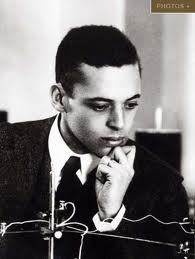Ernest Everett Just
Ernest Everett Just was born August 14, 1883 in Charleston, South Carolina, he was a pioneering Biologist, Academic and Science Writer. His primary legacy is in his recognition of the fundamental role of the cell surface in the development of organisms. In his work within marine biology, cytology and parthenogenesis, he advocated the study of whole cells under normal conditions rather than simply breaking them apart in a laboratory setting.
When Just was young he became dreadfully sick for 6 weeks with typhoid fever. He had a hard time recuperation as his memory was greatly affected. While he had been lauded for learning so much at a young age, he now had to relearn everything. His mother worked with him but became impatient and gave up on him. He persevered and finally read by himself, however he kept the information from his mother for a month because he felt betrayed by her when she had given up on him and stopped teaching him to read.
He was sent to an all black boarding school in Orangeburg, SC at the age of 13, however when he was 16 his mother sent him to Kimball Union Academy in Meriden, NH because she felt that the south did not provide adequate education for Blacks. She died in his second year at Kimball and he missed her burial by an hour. Despite this tragedy, Just graduated in 3 instead of 4 years at the top of his class and Phi Betta Kappa in 1903. He went on to graduate Magna Cum Laude from Dartmouth where he received special honors in Zoology and distinguished himself in Botany, History and Sociology. He was also honored as a Rufus Choate Scholar for 2 years.
Just faced the problem that many talented African American College graduates faced, not finding a job in his field, thus began his tenure at Historically Black Howard University. He first taught English rhetoric in 1907, far from his scientific studies. In 1909 he began teaching English Biology and by 1910 he was named head of the newly formed Biology Department. Then in 1912 he became head of the Zoology department which he held until his untimely death.
Just met Dr. Frank R. Lillie the head of the Biology Department at The University of Chicago, who was also chief of The Marine Biology Laboratory (MBL) in Woods Hole, Massachusetts in 1909. The next 20 years all but one summer, Just spent at MBL doing research. In 1915 he took a leave of absence from Howard to enroll in an advanced academic program at The University of Chicago. He also received the first NAACP Spingarn Medal, February 12, 1915. Due to his schedule and obligations at Howard, Just earned his PhD in 1916 in Experimental Embryology with a thesis on The Mechanics of Fertilization from the University of Chicago.
On November 17, 1911, Just assisted Howard Students, Edgar Amos Love, Oscar James Cooper and Frank Colman in establishing Omegas Psi Phi Fraternity despite the University's administration reluctance.
In 1930, he became the first American invited to the Kaiser Wilhelm Institute in Berlin, Germany where many Noble Prize Winners worked on their research. He made a total of 9 visits to Europe to pursue research as he was treated like a celebrity amongst the Scientific community, especially the European community. He was encouraged to extend his theory on the Ectoplasm to other species. In 1933 due to the Nazi's taking over he ceased to work in Germany and relocated his European based studies to Paris.
At the outbreak of World War II, Just was working at the Station Biologique in Roscoff, France researching what would become his paper, The Unsolved Problems of General Biology. He ignored the French Government's request that all foreign citizens evacuate and was captured by the Germans when they invaded France and became a Prisoner of War. The United States Department of State rescued Just in September 1940. However Just had been sick prior to his arrest and his condition worsened while he was imprisoned. In the Fall of 1941, he was diagnosed with Pancreatic Cancer and he died shortly thereafter on October 21, 1941
Just wrote 2 books, Basic Methods for Experiments on Eggs & Marine Mammals (1922) and The Biology of the Cell Surface (1939), and several papers during his lifetime.
The Biology Building at Howard University is named for Just and is located on the University's campus in The Valley, which is also home to several other Science buildings.





Comments
Post a Comment